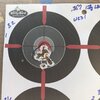Handgun Ladder Loads w/o a chrono ... Whats most critical to accuracy? Velocity, max spread, or standard deviation?
Holes on target - Accuracy trend representing accuracy nodes during powder work up and verified by subsequent range tests to confirm consistency.
A chronograph measures velocity, not accuracy ... Your target measures accuracy.
Trust the target, ignore the chronograph.
+1.
Often, smaller groups are produced with powder charges that produced higher SD/ES. And sometimes, accuracy is produced with lower velocities (lighter target loads) when we anticipate greater accuracy as we approach max charge from more efficient powder burn (I see this often with faster burning powders).
Is a chrono the answer to figure out what your gun likes or does it just take a lot longer to get there without one?
No.
Reloaders and match shooters have been identifying accurate loads long before advent of chronos.
I haven't found much difference in 1 or 2 tenths of a grain as far as accuracy goes
That's what I used to think but as I became more OCD about reloading variables and worked to eliminate/reduce them, I began to see that .1 - .2 gr could show on target especially when start/max charge range is around .5 gr for many powders (Particularly for small internal case volume higher pressure 9mm where small changes can produce significant results in chamber pressures).
Take a look at the IMR Target powder work up showing accuracy node where difference in powder charges are around .2 gr -
https://www.thehighroad.org/index.p...rget-any-favorite-loads.877952/#post-12033527
4.0-4.1 gr: 1008-981-991-1023-1034 fps
4.2-4.3 gr: 1049-1053-1067-1055-1085 fps
4.5-4.6 gr: 1162-1166-1138-1110-1151 fps
And same powder charge that reduced group size from slight reduction in OAL. There are reloaders who experience bullet setback around similar difference in OAL. But of course, if you do not measure bullet setback, you just won't know.

So if you are not seeing much difference from .1-.2 gr powder charge, it may be the case where other reloading/shooting variables are overshadowing the difference from powder charges.
In the recent myth busting digital scale zero drift thread, we discussed this where zero drift may not matter if other reloading/shooting variables overshadow accuracy/consistency of powder charges. But to match shooters like Nature Boy who have worked to eliminate/minimize other variables, .1 to .2 gr or even resolving powder charge to single kernel may matter.
BTW, here's a listing of reloading variables and myth busting work to eliminate/minimize them -
https://www.thehighroad.org/index.p...-and-discussions.778197/page-10#post-10966692





